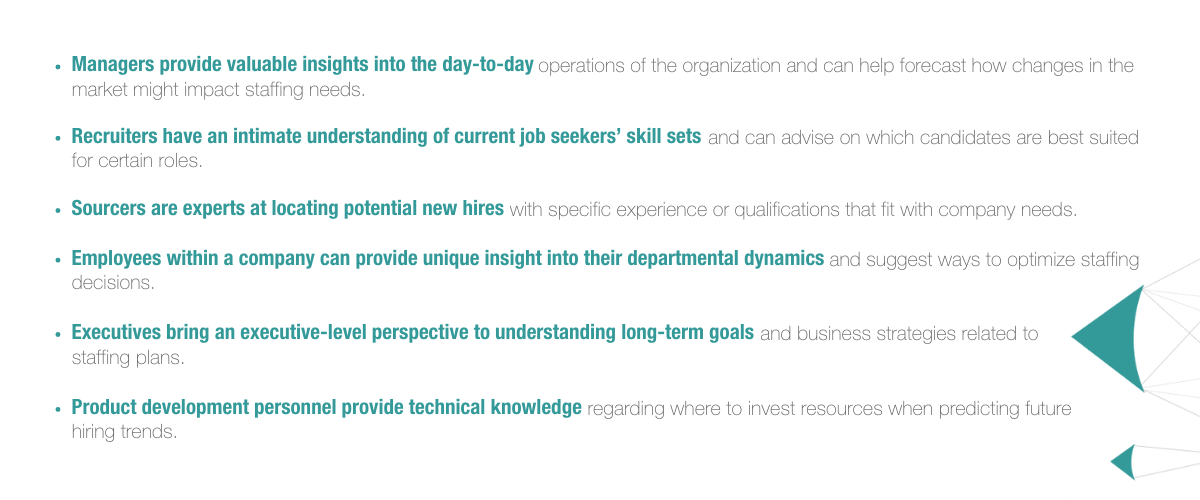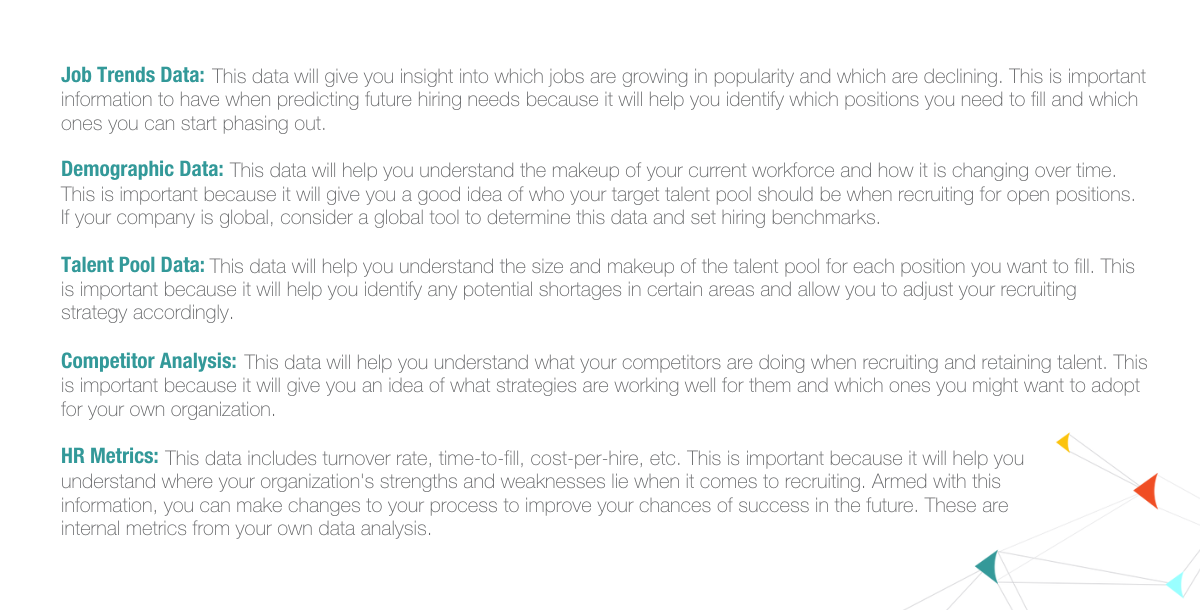How to Accurately Predict Future Hiring Needs

Predictive Hiring and Workforce Planning
So, what is predictive hiring? Predictive hiring is the process of using data and analytics to identify future hiring needs and trends. By understanding the patterns and trends in your data, you can make better-informed decisions about your workforce planning and Talent Acquisition strategies.
A predictive hiring system is a powerful tool that uses candidate characteristics to anticipate how successful they may be in a given role by analyzing their skills, experience, and qualifications. Additionally, companies could use predictive models to analyze external factors such as market demand or competitors’ strategies to identify emerging roles and anticipate their future hiring needs. By adopting a predictive hiring system, companies can build an agile workforce that is better prepared to respond quickly to changes in the market and shifting customer demands.
Predicting future hiring and predicting the workforce’s future needs when influenced by external factors is an intricate process that requires a detailed analysis of data types such as job trends data, demographic data, talent pool data, competitor analysis, and HR metrics. It is important to consider who will be responsible for planning and forecasting the timeline and job positions to make accurate predictions.
Creating a predictive hiring model is an invaluable tool for workforce planning, allowing employers to accurately predict future hiring needs and stay ahead of the curve. With the power of predictive hiring, employers can leverage existing data sources and methodologies to formulate an accurate projection of upcoming talent requirements.
From analyzing past performance indicators to evaluate the current job market landscape, predictive hiring models give employers the insight they need to proactively plan their workforce strategy. By creating a task force that includes people with diverse skill sets and backgrounds, employers can effectively incorporate a range of factors into their predictive model. With information such as historical trends in labor supply and demand, industry forecasts, economic growth projections, demographic shifts, and skill set analysis all factored in, employers can make sure their workforce is ready for whatever challenges may arise. Ultimately, by utilizing a predictive hiring model as part of their total talent roadmap, employers can maximize resource efficiency while staying competitive within their industry.
How to Create a Predictive Hiring Model
To create a predictive hiring model, one must first understand the nature of the task and set clear objectives. This includes determining which job positions should be focused on, the timeline for when hires need to take place, and who will be responsible for planning/forecasting. Once these goals are established, data types such as job trends, demographic data, talent pool data, competitor analysis, and HR metrics must be collected and analyzed.
From there, five common techniques can be employed to predict future hiring needs: the Markov model (which helps analyze changes in demand over time), workload analysis (which evaluates existing workloads to determine future demands), managerial analysis (which considers managerial decisions and their impacts on the workforce); nominal group technique (which allows stakeholders to collaboratively brainstorm ideas that influence hiring decisions); and Delphi technique (which allows experts to share their insights anonymously). By utilizing these methods with accurate data sets, businesses can develop an effective predictive hiring model that will help them meet their future workforce needs.
When building a predictive hiring model, it is essential to consider who will be responsible for planning and forecasting the timeline and job positions to make accurate predictions. It is important to create a cross-functional team with various roles that can offer different perspectives on the model. The team should include managers, recruiters, sourcers, employees, executives, and product development professionals, who all play a vital role in predicting hiring trends.

All these perspectives must be considered when creating a predictive hiring model so that accurate forecasts can be made about what types of job positions are needed and when they should be filled to remain competitive in the market.
Incorporating Your Talent Roadmap when Building a Predictive Hiring Model
One of the most important things to keep in mind when building a predictive hiring model is your talent roadmap. Your talent roadmap is a strategic plan that outlines the skills and competencies your organization will need to meet its business goals. When developing your predictive hiring model, you’ll need to make sure that it aligns with your talent roadmap so that you can accurately forecast the skills and competencies your organization will need in the future.
Benefits of Developing a Talent Roadmap
A talent roadmap provides valuable benefits to recruitment team leaders, helping them make informed decisions about their staffing strategies. By taking into account sourcing, recruiting, workforce planning, assessment, and selection criteria, a talent roadmap allows leaders to keep track of the progress of their hiring goals in terms of both current and future needs.
The roadmap also ensures that the right individuals are recruited based on their skills, experience, and qualifications. In addition, it facilitates the optimization of resources through more efficient utilization of personnel within an organization. Furthermore, it enables leaders to analyze potential recruits from multiple perspectives, such as educational background, work history, and professional skills, for more effective decisions. Overall, this leads to improved future workforce development and better chances for organizational success.
Read More About Creating Your Talent Roadmap
Data Types Required for Forecasting Future Hiring Needs
In order to build a predictive hiring model that accurately reflects your organization’s future hiring needs, you will need to gather data on several factors. These data types include:

Five Ways to Accurately Predict Future Hiring Needs
Once you have gathered all of this data, you can start to build your predictive hiring model using one (or more) of the following five methods:
Markov Modeling Methodology
In terms of predicting future hiring needs, Markov models can be used to identify patterns in job openings and hires over time so that organizations can better anticipate their staffing needs in the future.
Workload Analysis Methodology
Workload analysis focuses on recent events to better predict short-term trends. In terms of predicting future hiring needs, workload analysis can be used to identify spikes or dips in job openings or hires so that organizations can adjust their staffing levels accordingly.
Managerial Analysis Methodology
With this method, businesses typically ask managers within their organization about their plans for the upcoming year (e.g., plans for expansion or contraction) so that they can better anticipate their staffing needs accordingly.
Nominal Group Technique
The nominal group technique relies on opinions from a larger group of experts (e.g., industry experts or consultants). When predicting future hiring needs with this method, businesses typically ask these experts about their predictions for the upcoming year so that they can better anticipate their staffing needs.
Delphi Technique
The Delphi technique is yet another qualitative approach that relies on expert opinion rather than hard data; however, unlike both managerial analysis and the nominal group technique—which rely on opinions from groups of people—the Delphi technique relies on opinions from individuals who are knowledgeable about the subject matter at hand.
Putting Predictive Hiring Models Into Practice
Accurately predicting future hiring needs is essential to workforce planning and total talent roadmap development. With a predictive hiring model, businesses can save time, money, and effort—all while ensuring they have access to the right people with the right skills at the right time. Engaging a recruitment expert at Recruiter.com can help business owners take talent management to the next level in 2023. A recruitment expert can guide your business through key steps such as building a predictive hiring task force, collecting data before beginning, and utilizing five methodologies to make accurate predictions.
By leveraging these expert services from Recruiter.com, companies can build efficient recruiting tactics that ensure successful outcomes from the start of their process. With an effective workforce plan firmly in place for 2023, businesses will be well-positioned for long-term success in an ever-changing talent landscape.
Step-by-Step Checklist to Create a Predictive Hiring Model:
- Gather relevant data sources: Employers should first obtain information from historical trends in labor supply and demand, industry forecasts, economic growth projections, demographic shifts, and skill set analysis.
- Analyze data: With the collected data sources, employers need to analyze this data using predictive models that will help them better assess their hiring needs for the future.
- Create task force: Employers should create a task force comprised of people with diverse skill sets and backgrounds to ensure all perspectives are taken into consideration when creating their model.
- Leverage existing methodologies: Using existing methodologies, such as machine learning algorithms, can help employers formulate an accurate projection of upcoming talent requirements.
- Establish resource efficiency goals: Assessing resource efficiency is essential in determining how well the predictive hiring model will be implemented within an organization’s overall talent roadmap.
- Monitor performance indicators: Once the predictive hiring model has been established, employers should regularly monitor performance indicators to evaluate its success and make necessary adjustments as needed.
NEXT STEP IN CONTENT FUNNEL
It’s time to think ahead and take your talent roadmap to the next level! Building a successful predictive hiring model and methodology is key to developing a resilient total workforce plan for the future. Take control of your organization’s talent development in 2023 by downloading our Total Workforce Planning Kit!
This comprehensive guide will provide you with valuable insights on:
- Identifying trends in hiring and what to expect over the next three years
- Building an effective predictive hiring policy that sets you up for success
- Leveraging analytics, data science, and AI to drive decision making
- Optimizing your Talent Acquisition process to ensure you’re getting the best hires
- Developing competitive compensation packages that keep top talent engaged
- Designing a holistic workforce planning strategy that ensures business continuity.
Don’t wait any longer – download our Total Workforce Planning Kit today. With this powerful toolkit, you’ll be equipped with all the knowledge needed to create a robust hiring plan that will set your company up for success in 2023!

